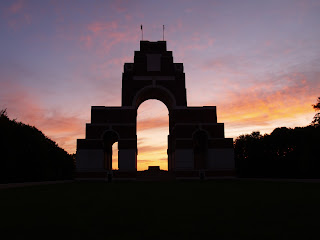If you are in Caen, Normandy don't miss
Le Memorial de Caen Museum (Peace Museum). This incredible museum tries to put history into perspective with a pre-1945 era and another section covering the post 1945 Cold War era. Sorry - no pictures to share of this fabulous museum. A must see for anyone interested in the past and future world in which we live....
I always knew the Great War of 1914 to 1918 was different than World War II but now I understand just exactly why it was so vastly different. However, after visiting several museums, multiple monuments and walking through half a dozen Commonwealth and German cemeteries I am no further ahead in understanding exactly
what this war was all about? What
carnage. What senselessness. Was it just political miscommunication and mishap?
Here is a Great War Canadian Cemetery....

Walking through these cemeteries is quite different to the WWII cemeteries around Normandy. Besides the greater number of lost souls, I was struck by the number of unmarked graves. Many of the graves mark more than a single unnamed soldier. Other graves name a soldier 'believed to be' a specific man, rank or regiment or a soldier from a specific country. If only a torso was found, or a single limb how can one identify the dead? So many of these young men were just blown to pieces. What carnage one would witness to look over these battlefields. It is no wonder media and photographers were restricted from taking pictures of this horror.
We stayed in
Butterworth Bed and Breakfast where the battles of the Somme took place. Last year, they dug up the partial skeletal remains of 2 soldiers - 3 femurs which is 2 unknown soldiers. They were able to determine one of these men was Canadian but despite modern day DNA testing officials could not precisely ascertain the identity. Again, "Believed to be....".
Imagine what it must have like for the mothers, fathers, wives and family to never have a marked grave to your loved one? This is one of the "lucky ones".....these gravesites have family coming to pay their respects even today.
Bodies continue to be found today almost 100 years later. Residents unearth artillery shells, trench screws (to fix barbed wire in front of the trenches), guns, helmets and various artifacts every day. In the Ypres and Passchendale area, 200 tons of shells and artillery are dug up
every year through the simple daily act of a farmer working his field. It is a daily occurrence and the people in these communities continue to live and breathe the history of this war even today.
We stayed at another wonderful B & B called
Varlet Farm in Ypres area. Charlotte is an extremely knowledgeable self taught historian and expert on the Great War after decades of working and farming this land. She is passionate about this subject and in this picture below is giving an informative lecture to a group of British Cadets on a field trip. Note the pile of artifacts found around their farm. These artifacts await pick up from the local "Bomb Squad". This unit is responsible for ensuring the appropriate disposal and discharge of all artillery and shells. Twice daily, at a specific time of day, the officials discharge live shells so as not to scare the locals of these communities.

|
Tyne Cot Cemetery and Memorial, the largest Commonwealth cemetery in the world, has 11,956 graves. The Memorial Wall bears the names 34,85723 men whose graves are unknown but perished in the Ypres Salient.....
Thiepval Memorial and Anglo-French Cemetery in the Sommes region which we caught at sundown.
Did you know that almost an entire community of young men of Newfoundland (A Dominion of Canada at that time) was wiped out in a single day on the first day of the Battle of Sommes in 1916? Of the 780 men in this regiment, only 68 were at the roll call the next morning. They were slaughtered in only 30 minutes and are commemorated at the Beaumont-Hamel Newfoundland Monument and memorial grounds where the former trenches exist today. That is a lost generation.
And another evening we attended
The Last Post Ceremony at Menin Gate in Ypres which is held every evening at 8 pm.
We would not be Canadian if we had overlooked the poignant Vimy Ridge......
And The Brooding Soldier at St. Julians........





















































